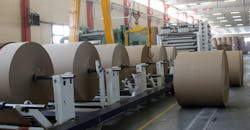Real Data Results Require Big Picture Potential
As manufacturers continue to invest heavily in becoming digital manufacturers, they are generating extraordinarily large amounts of data. So much so that most manufacturers struggle to fully realize the power or potential of the data they are creating and collecting.
Sight Machine is confident it has the solution. With eight years of experience in transforming industrial data to achieve concrete metrics in quality, output, availability sustainability and profitability, Sight Machine offers a big picture view to make sense of all the raw data found across discrete and continuous manufacturing environments.
Sight Machine leverages data from the entire process – making use of whatever systems are in place whether its sensors, a bunch of receivers, or an existing PLC system. It then streams the data into a data lake in the cloud to initiate a modeling process. “We then have the basis for a structured data environment to run the analytics needed to solve whatever issues exist,” says John Merrells, head of product and engineering.
Fueling Continuous Improvement
For a growing number of manufacturers, being able to leverage data is a crucial component to enabling continuous improvement. Unfortunately, after a few wins, the process often slows to a crawl. And according to Sight Machine CEO and Co-Founder Jon Sobel, it's not because people aren't using good methods to try to problem solve. Instead, he suggests that most have reached the limit of what they can solve, given what they see.
“Manufacturers need to be able to see so much more about what the problems are and what's causing them. They have squeezed out most of the gains available from optimizing individual machines and processes,” says Sobel. “The largest opportunity for today’s manufacturers to gain competitive advantage is from data, specifically through real-time, system-wide optimization. We are investing in industry-specific solutions that accelerate the ability of manufacturers in industries such as paper & tissue, packaging and chemicals to revolutionize operations and achieve continuous breakthroughs in productivity, profitability and sustainability.”
Continuous improvement can be a much more powerful method, when it's informed by data. Sight Machine is focused on unlocking the next level of continuous improvement by expanding the view from a single asset to the entire system. Sight Machine’s Manufacturing Data Platform (MDP) puts more capabilities into the hands of corporate executives, factory management and line workers, giving them the power to make data broadly impactful.
MDP has three layers:
· Data acquisition software that collects and unifies production data in one central place;
· A streaming data pipeline that continuously processes, transforms, and blends sensor data as it’s generated in real time; and
· Standardized, configurable manufacturing models into which the blended data is channeled to digitally represent a specific production process from end to end.
“Considering the number of variables in today’s manufacturing environments, organizations need the power of cloud computing and machine learning algorithms,” says Sobel. “Being able to the model the data across the entire process, instead of a single asset, makes it possible to find correlations that enable you to pinpoint causation. You can remove bottlenecks, and continuously find and solve problems across the entire system.’
The primary challenge? Organizational readiness. “When we have big picture access to data, we know we're going to be able to accurately, and continuously represent what's happening,” says Merrells. “However, it’s a truly transformational change for companies to develop this kind of transparency, and to get people who haven't previously worked together to do so around data,” he says. “It's something that a lot of companies want to do, but is actually quite difficult. And it often requires very close collaboration within the company, and with their providers.”
Case in Point
Sight Machine delivers the ability to see the upstream and downstream implications of that that machinery and of that whole process. As a result, the operator can understand how upstream machines impact the downstream equipment.
Consider an example within the paper industry, where machine availability is heavily connected to quality. If the quality of the product is not good, it can tear, creating jams that negatively impact availability.
This system wide view enabled a paper production facility to identify the reasoning behind a longstanding bottleneck in the line. It turned out that in order to meet quality levels, the operators at that station slowed the machine down. The unintended consequence? It slowed the entire production process down. And while they achieved their quality metric, the system could not hit KPIs. Attacking that issue led to a noticeable improvement within a week.
About the Author
Peter Fretty
Technology Editor
As a highly experienced journalist, Peter Fretty regularly covers advances in manufacturing, information technology, and software. He has written thousands of feature articles, cover stories, and white papers for an assortment of trade journals, business publications, and consumer magazines.

